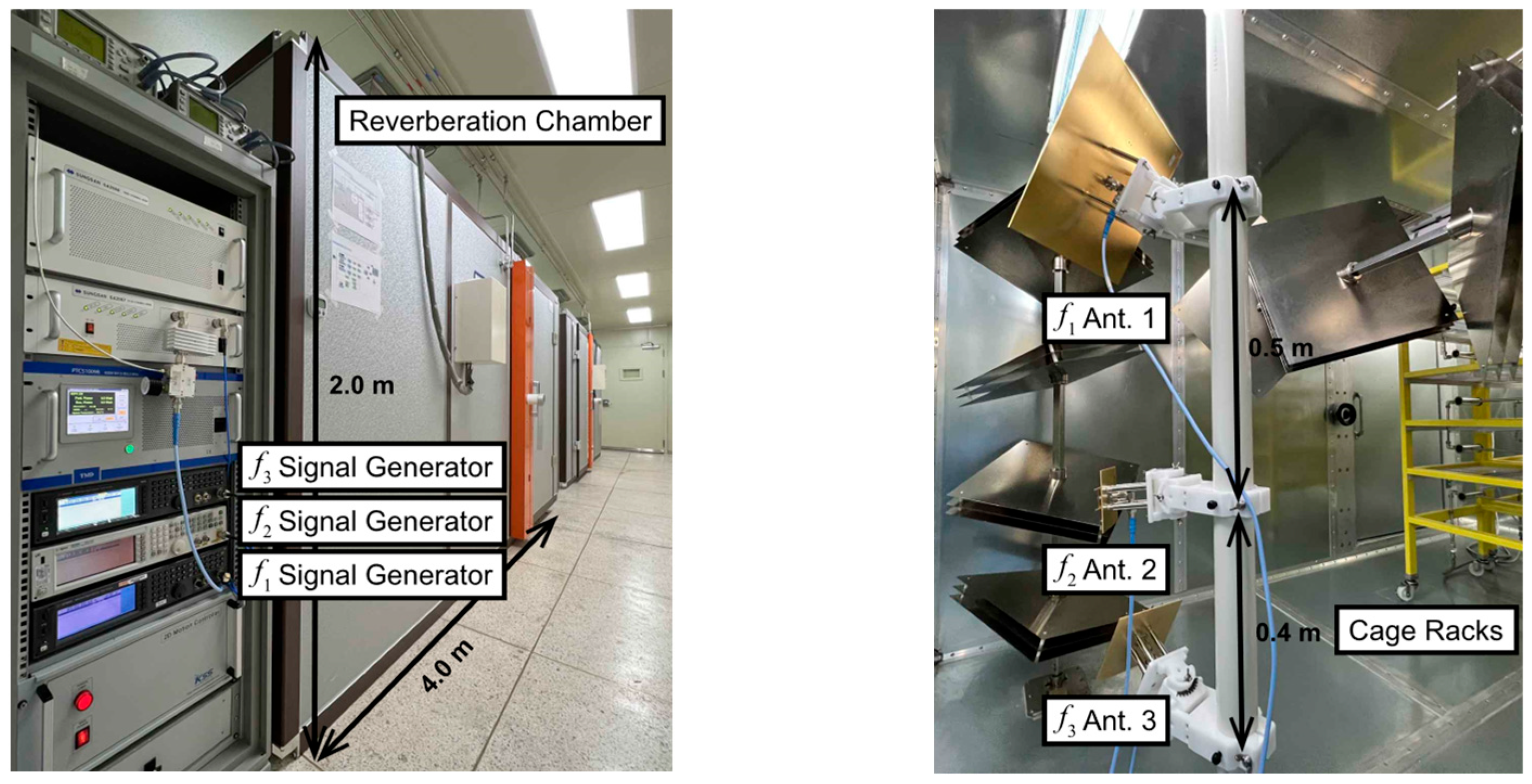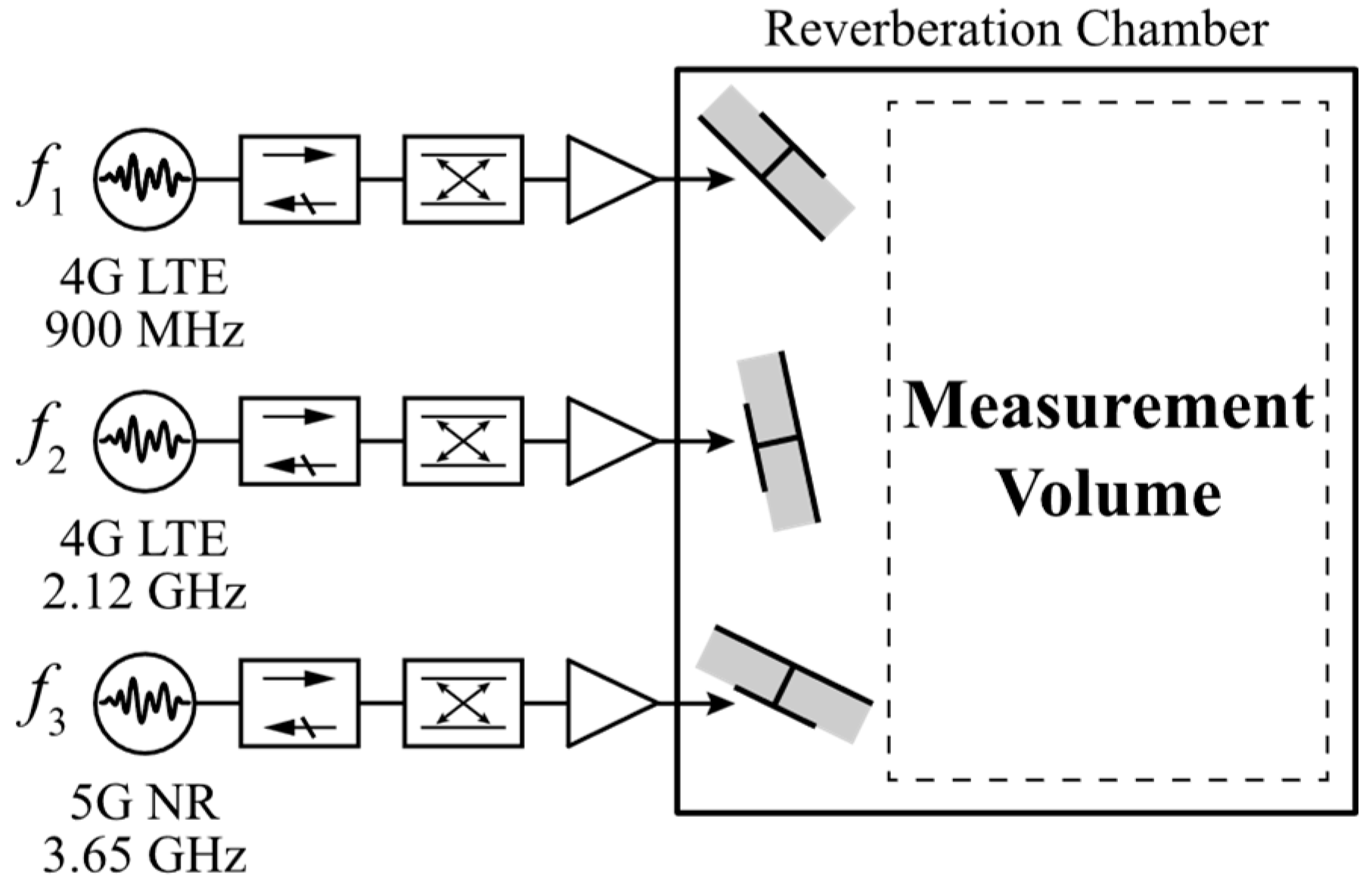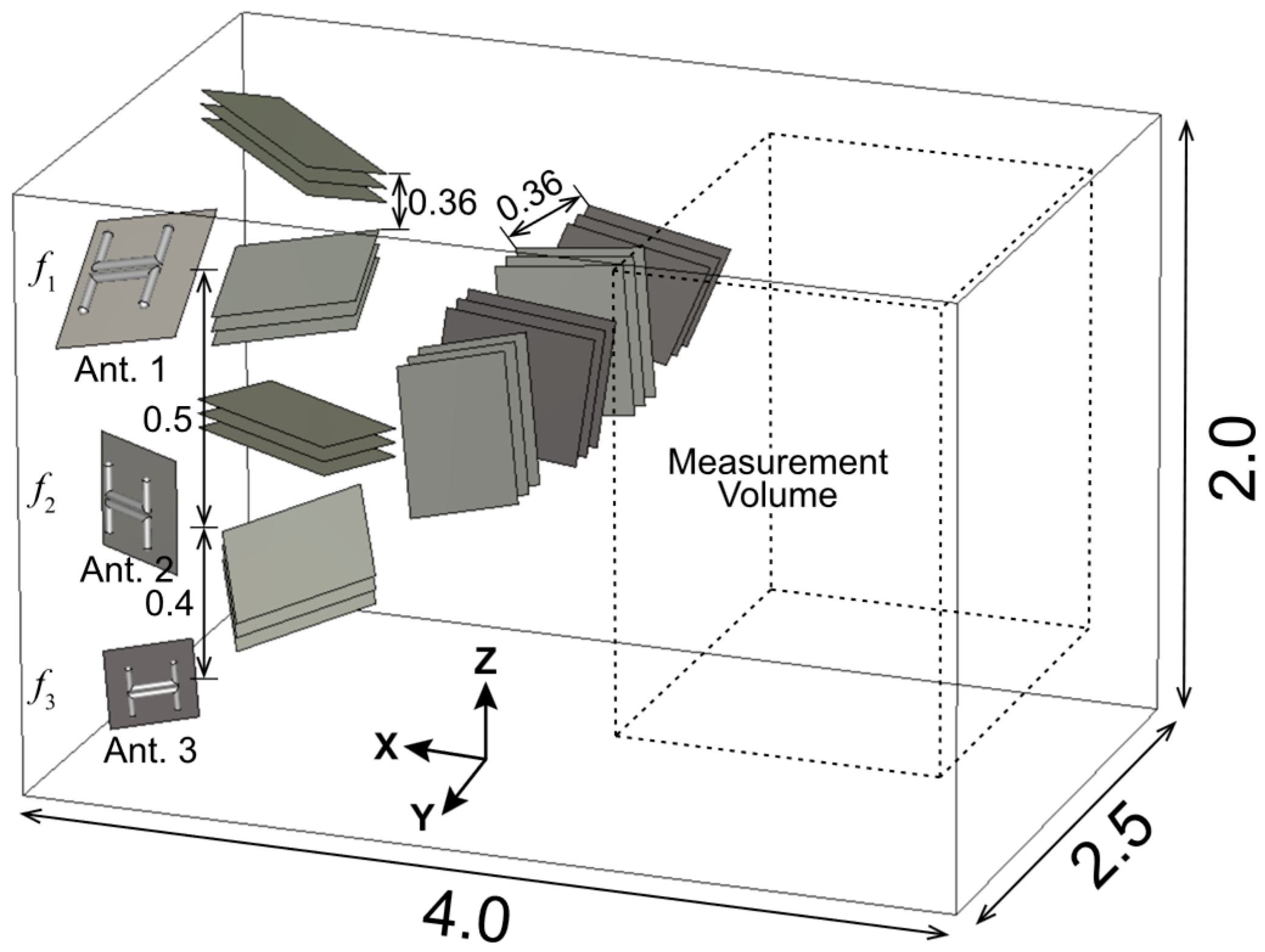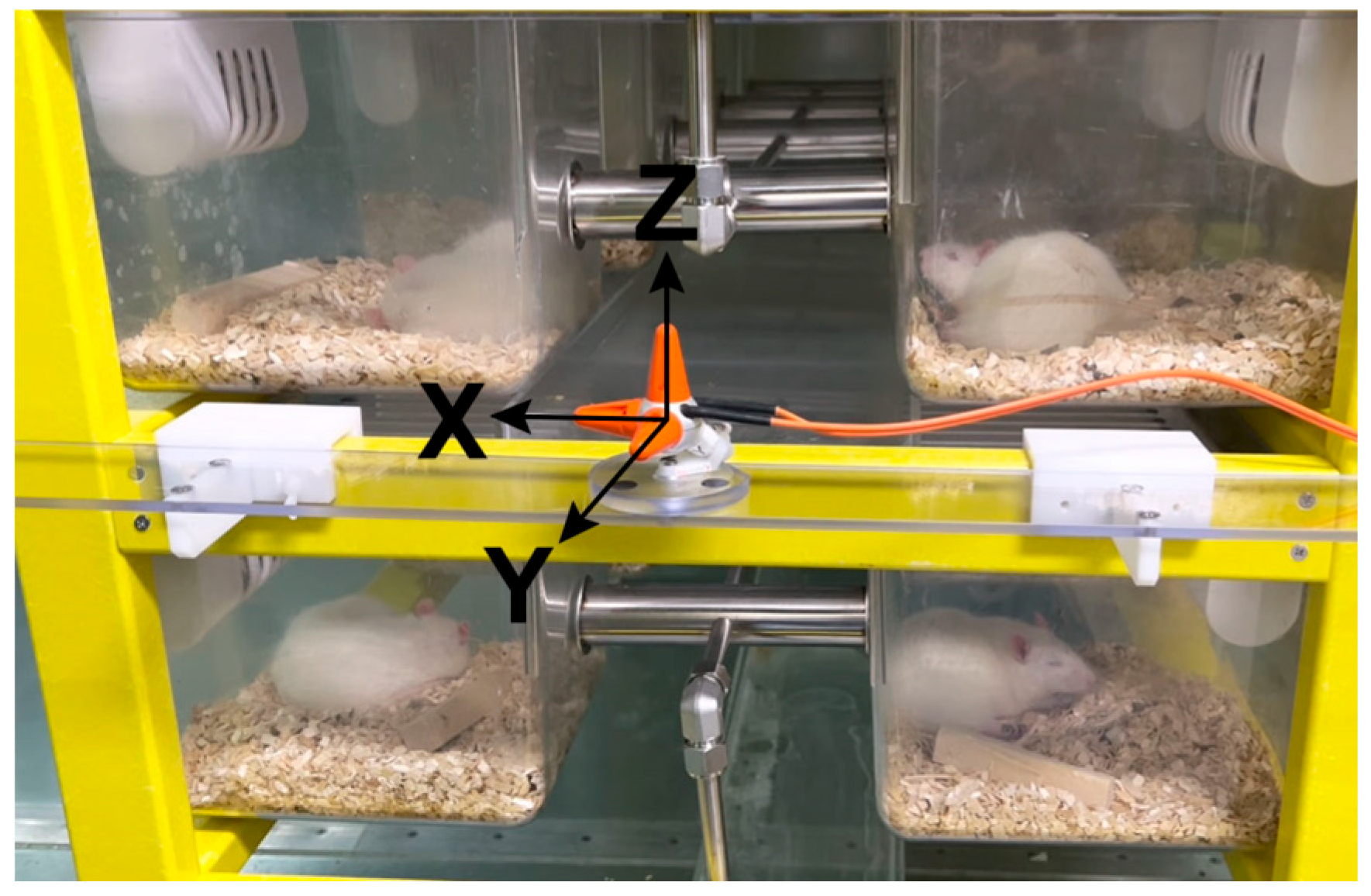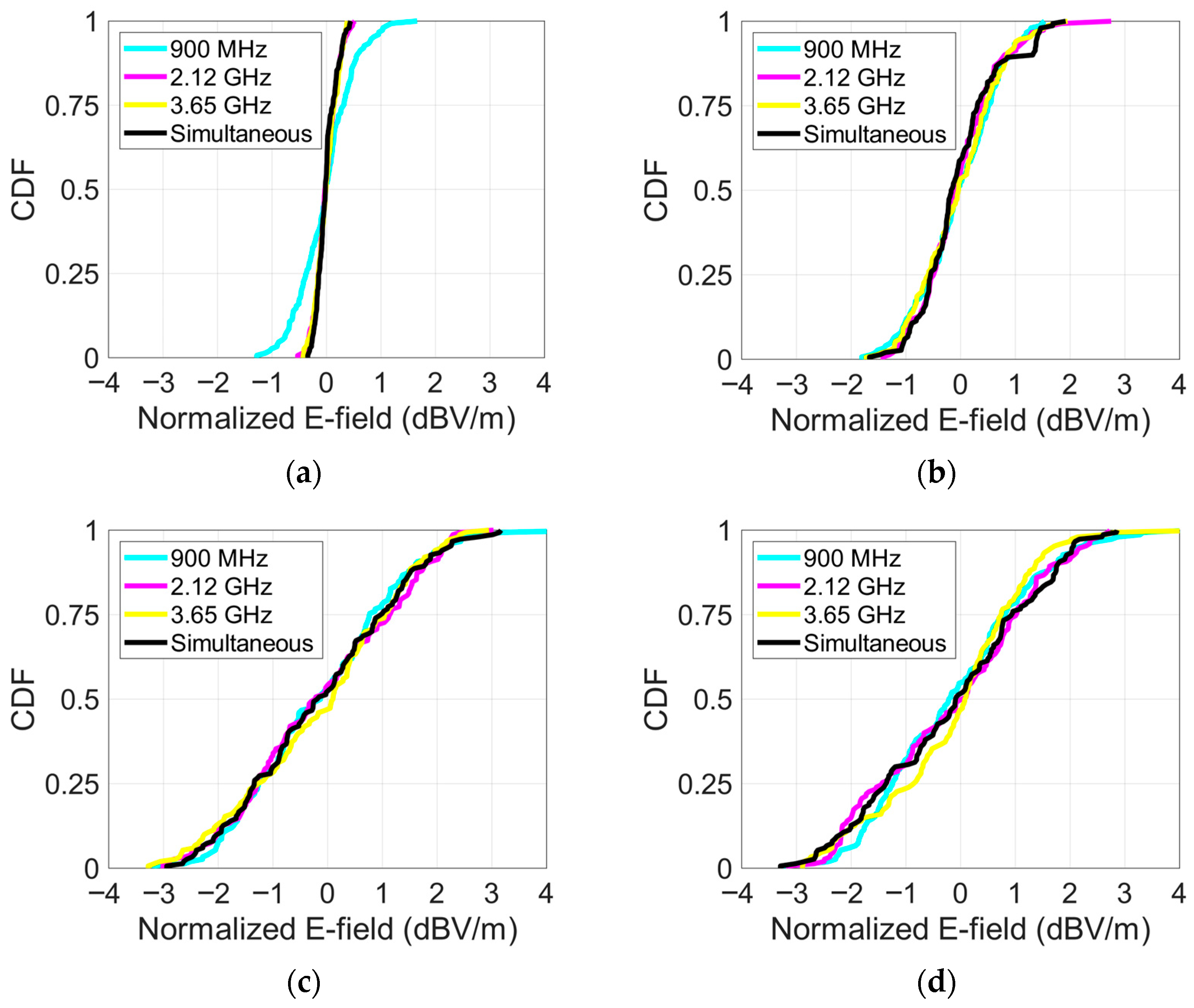1. Introduction
Research on cancer associated with RF electromagnetic field (EMF) exposure has attracted public interest and has been designated as one of the priority research subjects by the World Health Organization (WHO) [
1]. Previous large-scale animal studies on carcinogenesis—such as those conducted by the National Toxicology Program (NTP) and the Ramazzini Institute—investigated the effects of RF EMF exposure from 2G mobile communication [
2,
3]. Subsequently, the first international joint animal study was conducted in South Korea and Japan to validate the results of the NTP study [
4]. However, 2G mobile communication technologies, such as code division multiple access (CDMA) in the earlier animal studies, are rarely used in modern communication technologies. On the other hand, 5G mobile communication systems operating in the frequency range 1 (FR1) band have spread rapidly. As a result, the EMF exposure environment is predominantly influenced by the simultaneous operation of 4G and 5G mobile communication systems. Such a combined exposure environment has led to increased public interest in carcinogenicity studies under realistic conditions, highlighting the need for research that reflects actual multi-source scenarios.
Therefore, the aim of this study is to develop an RF EMF exposure system that can produce simultaneous exposure to both 4G and 5G modulated signals for use in long-term carcinogenicity studies. This work extends previous research on reverberation chambers (RCs) for animal exposure by evaluating system performance under concurrent 4G and 5G signals exposure conditions [
5]. Above all, this is the world-first system specifically designed for large-scale carcinogenicity studies involving simultaneous exposure to multiple frequencies, including 5G FR1 band. The implementation of a multi-frequency RF EMF exposure environment can reflect public concerns by replicating realistic exposure conditions in animal experiments. Based on the measurement result of the downlink EMF exposure collected in 2023 from Seoul [
6], we selected 900 MHz, 2.12 GHz, and 3.65 GHz as representative 4G and 5G bands, and using the cumulative distribution function median (50th percentile) downlink electric field (E-field) levels—117.13 dBμV/m, 119.35 dBμV/m, and 117.46 dBμV/m, respectively—derived power-share weights of 27%, 44%, and 29%, which were adopted for the simultaneous exposure condition.
Across recent RC studies, field uniformity has been regarded as a performance indicator and is almost quantified by the standard deviation of the composite E-field over a defined working volume. For example, a novel 3.5 GHz RC design for bioelectromagnetic experiments focusing on uniform field generation is presented [
7]. Vibrating intrinsic RCs report standard deviation dropping below 3 dB once the wall-shaking amplitude exceeds about 0.125λ, establishing a practical uniformity target for design and operation [
8]. In cylindric RCs, detailed modal analyses near the lowest-usable frequency show typical standard deviation values on the order of 3.6–4.0 dB across the test volume, illustrating the frequency-geometry trade-offs that govern achievable uniformity [
9]. Beyond standard deviation analysis, several studies link improved uniformity to design choices, e.g., adequate stirrer rotation volume (about 10% of cavity volume) and statistical goodness-of-fit test to verify a random and isotropic field, both now common practice in RC validation [
8,
10].
In this paper, we present the design, construction, and comprehensive performance evaluation of the developed RC. To evaluate performance of the animal exposure system, the E-field uniformity inside the RC is assessed at each individual frequency [
11,
12]. Unlike our previous studies, which were limited to single-frequency exposure at 900 MHz using chamber systems, the proposed study is, to our knowledge, the first worldwide to propose and validate a multi-frequency RC system that incorporates the 5G spectrum for large-scale animal studies. Finally, we discuss the potential utility of a predictive calculation model for estimating E-field intensities and variations in multi-frequency exposure environments, which could reduce the number of repeated E-field measurements and shorten the evaluation time for such complex settings.
3. Measurement and Discussion on Single-Frequency Exposure Condition
Figure 6 illustrates the cumulative distribution functions (CDFs) of normalized E-field intensities measured at 150 points within the RC under the four loading conditions. Measurements are performed separately at the three frequencies and simultaneous exposure. The CDFs provide insight into the spatial uniformity of the E-field: steeper slopes indicate tighter clustering of E-field intensities around the mean, representing better uniformity, whereas gentler slopes reflect variability. As shown in
Figure 6, consistently steep slopes across various loading levels and frequencies demonstrate the RC’s ability to maintain stable and highly uniform E-field distribution, even with the presence of cage racks and rats.
Table 2 presents measured composite E-field intensities averaging 150 measurement points and corresponding uniformity under the four loading conditions across the three individual frequency,
f1 (900 MHz),
f2 (2.12 GHz),
f3 (3.65 GHz) conditions.
Table 2 indicates that E-field intensities decrease significantly as loading increases, suggesting the cage racks and rats introduce scattering effects or field absorptions. With greater loading in the RC, inter-frequency differences in E-field uniformity diminish as shown in
Table 2, even when the load increases with the increase in animal weight, the loading-induced differences across frequencies remain within the measurement uncertainty. The standard deviation of the measured E-field intensities in
Table 2 illustrates variability within the RC. Lower loading (empty condition) shows relatively small variability, indicating the spatial E-field uniformity. However, introducing cage racks and rats increases the variability due to the shadow effect, but reduces differences among frequencies.
The larger variability observed at 900 MHz in the empty loading condition arises from mode density. In a fixed volume RC, the cumulative number of resonant modes increases approximately with
fi3 where
fi is operating frequency (
i = 1, 2, 3); hence higher frequencies provide more independent field realizations per stir interval and tighter spatial statistics. The RC provides an electromagnetic field exposure environment based on its cavity structure, and the number of resonant modes is determined by frequency [
16]:
where
ν is the speed of light, and
a,
b,
c is for the dimension of the rectangular cavity. For the designed RC with the dimension of 4.0 m × 2.5 m × 2.0 m, the estimated cumulative mode counts are approximately 4.47 × 10
3 at 900 MHz, 5.87 × 10
4 at 2.12 GHz, and 3.00 × 10
5 at 3.65 GHz [
5]. Under the empty loading condition, as frequency increases, the number of resonant modes grows substantially. This three-order-of-magnitude growth from 900 MHz to 3.65 GHz explains why the empty loading condition standard deviation is largest at 900 MHz and decreases systematically with frequency, consistent with the uniformity values reported in
Table 2.
By contrast, 3.65 GHz consistently yields the lowest E-field uniformity across loads because the RC is electrically much larger at higher frequency: the mode count scales approximately as
fi3, the stirrers and antennas as electrically larger, and the coherence bandwidth shrinks (
BC ∝
fi/
Q), all of which produce more independent E-field realizations during the same 1 min averaging interval. This frequency-scaling persists under loading: although
Q decreases and
BC widens with added loss, at 3.65 GHz, the effective number of independent realizations over space and stir time remains larger than at the lower bands, explaining the systematically smaller scatter (lower uniformity value) observed at
f3 in
Table 2.
‘Uniformity (dB)’ values in
Table 2, calculated by the equation B.7 in Annex B of IEC-61000-4-21, which can be obtained as follows [
14]:
where
μ is the normalized 1 min time-averaged E-field intensity averaging 150 measurement points at each loading condition and frequency, i.e., the ‘Average E-field (V/m)’ in
Table 2.
σ in Equation (2) is the standard deviation of E-field and is the same as the value in the ‘Standard Deviation (V/m)’ column of
Table 2. These results show that once the RC experiences a certain degree of loading, additional changes in frequency have only minor effects on uniformity performance. Even under realistic loading conditions involving cage racks and rats, the E-field uniformity of the RC within 1.36 dB. This outcome fully meets the 3 dB uniformity criterion specified by standards. Therefore, the designed RC maintains stable electromagnetic conditions crucial for reproducible large-scale experimental animal study.
The quality factor (Q-factor) is one of performance parameters of an RC. A high Q-factor is associated with enhanced field uniformity and efficient energy storage within the chamber. According to the IEC-61000-4-21 standards [
14], an RC’s operational Q-factor should exceed a defined threshold value to ensure satisfactory test conditions. We calculated the Q-factor from the measured E-fields in
Table 2 for the proposed RC using the average shielding effectiveness of an electrically large enclosure for the exposure conditions, as shown in
Table 3 [
17]:
where
V is the physical dimension of the RC,
μ is ‘Average E-field (V/m)’ values in
Table 2,
μtx is the antenna efficiency of each antenna,
Z0 is the impedance of free space,
λ is the wavelength. The computed Q-factors of the RC exceed the corresponding threshold values for all the measured frequencies and loading conditions. Specifically, even under the highest loading condition (Apparatus + Rat 520 g), the calculated Q-factors surpass their threshold Q-factors, confirming the RC’s good electromagnetic performance for large-scale animal studies.
Across loading conditions, the measured Q-factor spans about 2 × 10
2 to 1.1 × 10
4 in
Table 3, tracking the increase in ohmic or absorptive loss introduced by cage racks and rats. A lower Q-factor under heavier loading widens the coherence bandwidth and shortens modal dwell time, which reduces frequency selectivity and helps suppress standing wave sensitivity, consistent with the small changes in E-field uniformity under 1.36 dB across loads. Importantly, all Q-factor values exceed the IEC 61000-4-21 standard threshold
Qthreshold at each frequency, confirming over a sufficient mode operation adequate for robust stirring and reliable animal dosimetry [
14].
4. Discussion on Simultaneous Exposure Condition
4.1. Simultaneous Exposure Measurements
The simultaneous exposure condition is configured with RF power ratios of 27%, 44%, and 29% for 900 MHz, 2.12 GHz, and 3.65 GHz, respectively, reflecting the statistical outdoor proportions of 4G and 5G mobile communication, and ensuring the total combined power matches that of a single-frequency exposure [
6]. E-field uniformity evaluation is performed under the simultaneous exposure condition in which three frequencies with 4G and 5G modulated signals were transmitted simultaneously and continuously.
4.2. Proposed Prediction
To predict the mean and variability of the composite field when the three test carriers are applied simultaneously, we treat the individual fields as statistically independent because the center frequencies (f1, f2, f3) are widely separated and the RC guarantees mode-stirred spatial decorrelation. If the total RF power is fixed (normalized to 1 W) and distributed among the carriers as fractions p1, p2, p3 (p1 + p2 + p3 = 1), the root-sum-of-squares (RSS) of the power-weighted single-frequency averages at one of the 150 measurement points under the simultaneous exposure condition provides an unbiased estimate of the E-field.
The simultaneous exposure condition combines the per-band fields under the assumption that the band-limited random fields are mutually uncorrelated. In a well-stirred RC, inter-frequency correlation is governed by the RC’s coherence bandwidth,
BC ≈
fi/
Q, so fields separated by Δ
fi >>
BC are effectively independent [
14]. Consistent with this criterion, statistical characterization of RC’s coherence bandwidth shows that
BC follows an approximately lognormal distribution with a median that scales as
fi/
Q; for
Q in the 10
2–10
4 range from
Table 3,
BC is orders of magnitude smaller than our inter-band separations, supporting the frequency-independence assumption across all loading conditions [
18]. Using the lowest Q-factor observed in our measurements (approximately
Q is about 196 at 900 MHz under Apparatus + Rat 400 g loading in
Table 3), the coherence bandwidth is
BC ≈ 900 MHz/196 ≈ 4.6 MHz; at higher frequencies or lighter loaded
Q is larger and
BC is even smaller. Our center frequencies (
f1,
f2,
f3) are separated by more than GHz, exceeding
BC across all loading conditions and satisfying the sufficiency condition Δ
fi/
fi ≥ 1/
Q. Therefore, the independence assumption is well-justified even when modal overlap increases with loading; in practice, mechanical stirring and 1 min time averaging at each point further decorrelate samples within each band. For different bands, a simple applicability check is min(Δ
fi) >> max(
BC). Under these conditions, the composite field at one of the 150 points under the simultaneous exposure condition can be predicted by the following RSS expression
ES:
where
Ei represents the measured average E-field at each frequency
f1,
f2, and
f3, respectively, normalized to an input power of 1 W, and
pi denotes the fractional RF power distribution among these frequencies (
p1 = 0.27,
p2 = 0.44,
p3 = 0.29). Equation (5) can predict the composite E-field intensity based solely on independently measured single-frequency data.
For example, in the case of the empty condition, the predicted value of the composite average E-field intensity under the simultaneous exposure condition, calculated from the data in
Table 2 using (5), is 57.1 V/m. Propagating first-order uncertainties through the same RSS relationship gives an equally compact expression for the standard deviation σ
S:
where
ES,n represents the RSS Equation (5) at
nth measurement point. These two closed-form formulas can apply to every loading condition because they rely only on per-frequency field statistics including loading effects and the chosen power split.
4.3. Measurement-Prediction Comparison
The comparison in
Table 4 shows that the variability in E-field uniformity distribution between the measurement and the prediction does not exceed 0.175 dB under any of the four loading scenarios. From a practical point of view, this small difference of 0.175 dB (≈2%) is insignificant compared to the time and effort required for full experimental measurements, and it further supports the utility of the proposed prediction model in large-scale animal exposure studies.
The RSS-based prediction assumes (i) band-to-band field independence, (ii) well-stirred, approximately Rayleigh-distributed fields within the measurement volume, and (iii) stationarity of loading during 1 min averaging interval. These assumptions can be challenged when the chamber Q-factor becomes very low (heavier loading), because the coherence bandwidth BC ≈ fi/Q widens; if any band spacing Δfi is not >> BC, residual inter-band correlation may bias the RSS estimate. The model can also degrade when stirring is insufficient (too few uncorrelated samples or poor stirrer movement), when near field effects or strong shadowing from racks or animals violate the diffuse-field assumption, or when inter-antenna coupling rises (reducing effective band independence). Practical non-idealities—probe positioning error, limited probe isotropy, time drift of Tx power, and slow changes in animals or water configurations—propagate to the composite estimate and should be included in the uncertainty budget. Extrapolation to other frequency splits is valid only if (a) the IEC 61000-4-21 uniformity criteria are met for each band, (b) a minimum Q-factor threshold is satisfied, and (c) inter-band isolation and S11 remain acceptable across loads. If any of these checks fail—or if prediction to measurement discrepancies exceed typical experimental uncertainty—the simultaneous case should be fully re-measured, or additional stirring/averaging and load stabilization should be applied before using the prediction model.
Because heavier loading lowers the RC’s Q-factor and increases modal overlap and absorption, the E-field becomes more diffuse and frequency-independent, so the simplified RSS equation of the simultaneous exposure condition better matches reality and decreases the difference between the measurement and the prediction. Although the prediction model does not fully account for the complex interactions introduced by the presence of cage racks and rats under loading conditions, the overall estimation remains within an acceptable margin. Therefore, this predictive calculation method provides a highly practical alternative to exhaustive direct measurements particularly valuable in large-scale experimental animal studies involving numerous simultaneous exposure scenarios, where repeated measurements are often impractical.
